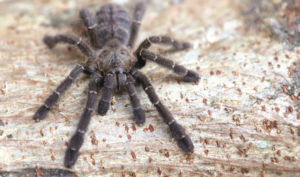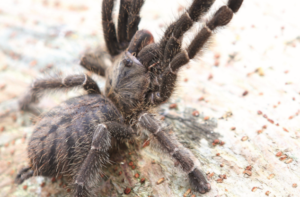It’s always good news when―during a time that many animal species are being declared extinct―new breeds are discovered. In the Philippines, one of those discoveries is the Philippine earth tiger tarantula, and Animal Scene sat down with Nyza Ho, biologist and tarantula aficionado, to learn more about it as she is among those who has devoted her efforts to studying and preserving this breed.
Discovered barely three years ago, this local species is considered to be exceptionally beautiful, particularly in comparison to other foreign species, explains Nyza. It is related to other earth tiger species under the subfamily of Ornithoctoninae. What’s their appeal to fanciers?

THE NEED FOR FURTHER STUDY
“The Philippine earth tiger is sought after for their massive adult size and their vivid patterns and colorations, especially on their legs and abdomen,” says Nyza, who is also an avid researcher on tarantulas, particularly local breeds. This is why she knows that there is very little research on the Philippine earth tiger.
As a result, no one knows how many there are in the wild― something that Nyza considers a cause for concern. “At the moment, we know very little about this new local species of tarantula… more research should be done to determine their status in the wild.”
Responsible breeders, she believes, have an important role to play in keeping the local Philippine earth tiger population levels high; they can breed the species then release the offspring “…back to their natural habitat, in the same place they were found, not in any other place,” she specifies.
Her concern is to preserve the Philippine earth tiger. “Since deforestation is one of the issues our country is facing, it is possible that the number of these specimens is declining; thus, captive breeding and releasing them back to the wild is a good step to ensure they are able to survive and thrive to be seen by the future generations,” she says.
Nyza continues, “More research needs to be done on this species. My ambition is to identify the local tarantula species here in our home country. Many local earth tiger species from this ancient subfamily are yet to be discovered―hopefully, by a Filipino this time, since most biodiversity surveys and expeditions are headed by foreigners and our local species are being named after foreign researchers. I believe that native species should be discovered and described by Filipinos.”
Like others who take pride in the biodiversity of the Philippines, Nyza plans to contribute to the body of knowledge about it in her own way. “I plan to study more about local tarantula and insect species for the biodiversity of our country to be known worldwide. This is my motivation to continue aiming for higher education: to research more about this species. For all we know, some species might’ve already been extinct without even being discovered and seen by the Filipinos.”

CARING FOR A FASCINATING BREED
Those experienced with tarantulas will be happy to know that the Philippine earth tiger are good display tarantulas when fully grown, “…since they are not very shy as adults and they like to climb barks. However as spiderlings or juveniles, they like to hide under the damp substrate, sometimes even making web tunnels similar to some fossorial (burrowing) species of tarantulas under the Ornithoctoninae sub family,” Nyza says.
Are there any special considerations in caring for a Filipino tarantula? “Philippine tarantulas generally like wet, damp, or moist substrate; this mimics the conditions of the rain forest in which they are found. Some local tarantulas prefer colder temperatures while others aren’t able to adapt to changing temperatures. The natural habitat must be taken into consideration when caring for a local tarantula, since very little information is known about them. The best way to care for them is to give them an enclosure which is the same as or very similar to their natural habitat.”
Because there are no care sheets available for the Philippine earth tiger, her experience is invaluable. “Most of the specimens I have are a bit skittish, but neither aggressive nor defensive…they are easily stressed and aren’t able to adapt to changing temperatures very well. Their natural habitat must be reproduced in captivity to ensure their survival and growth.” Thus the Philippine earth tiger is not a tarantula for the casual fancier who is not prepared to invest their time and effort in the breed’s care.
Those who want to keep Philippine earth tigers need to study them carefully and understand their particular needs very well. “Some Philippine tarantulas are very sensitive to the changing temperatures and humidity in their enclosures, which is something I often check. Caring for local tarantulas can sometimes be a trial and error [thing] due to the lack of information about every local tarantula species, unlike the foreign tarantula species [whose] caresheets are all over the internet.”
What about their diet? Nyza explains, “Tarantulas generally eat roaches, worms, and other small animals it can devour; the only food items they should avoid are insects which have been exposed to harmful chemicals or insects which have developed a resistance to these harmful chemicals such as insecticides, pesticides and others.”
As for socialization, unless it’s mating season, “…the Philippine Earth Tiger prefers to be housed alone, just like most pet tarantula species today.” They are territorial, but they are not very aggressive towards their mates unless the female is hungry, “…so during some (but not all) breeding attempts of local tarantula species, the males can be left with the females for days without being eaten. Generally, male tarantulas are consumed by the females before or after mating attempts,” Nyza says. She’s started her own breeding program and “…I’m hoping for a positive outcome for this breeding attempt.”
A LONGTIME FASCINATION
Has she always been a fancier of tarantulas? How did she get into them and what was their appeal to her? Nyza smiles and gives us a detailed background by way of explanation: “I really like animals in general, since I’m not very good in caring for plants. Animals have always been close to my heart; [they are] like a piece of nature which I can always enjoy and experience in my own home.”
Thus, even as a very young child, she was surrounded by pets, “… sometimes to the point that they are all over the place, but I still enjoyed their company. I originally liked small animals―mainly hedgehogs, hamsters, fish, small dog breeds, and some exotics when I was younger. However, during that time, the only exotic pet I could care for were hedgehogs and they were available in the local pet store; though [they were] pricey that time, I really enjoyed having them.”
Her foray into the ‘advanced’ exotics began with a local forest scorpion. “I continued to research more on invertebrate pets, but not yet care for them that time since it was frowned upon at home. It was only when I moved out of the house and rented my own apartment was when I finally started to care for the venomous and exotic pets. I still care for them until now and my collection just keeps on increasing every time I see a specimen I like.”
Local species will always be close to her heart, though. “I am most interested in local species since I want to learn more about them and hopefully conduct my own research about them and identify them properly, [so that they can] be known globally so the world can see the beautiful biodiversity of the Philippines on land as well, since most of the local research expeditions were focused on marine biology and limnology.”
The rarity of local species appeals to Nyza, who has long studied tarantulas. “However some specimens can be easily found in anyone’s garden or yard such as the P. baeri,” she says, while noting that most Filipino tarantula keepers “…prefer to keep foreign species of tarantulas and scorpions as pets, probably due to the colonial mentality of the Filipinos but very few are aware of the rare and beautiful Philippine Earth tiger specimens only a handful of keepers have.”
And what drives her when it comes to local tarantulas? “There are a lot of things to be learned about local tarantulas, which adds to their appeal to me, and as for me being a researcher, I am very eager to take note of the things I discover about their temperament, preferred enclosure/setup, and their other habits which makes them unique to other species.”
Photos by Jeffrey C. Lim
This story appeared in Animal Scene’s April 2015 issue.






